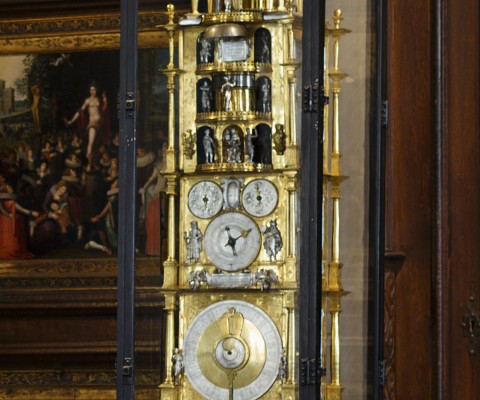Astronomical clock
A magnificent example of an astronomical clock, with a carillon and moveable figures, made by the Swiss watchmaker Isaac Habrecht in 1594. Habrecht was one of the main figures behind the famous cathedral in Strasbourg, where he spent most of his life. The clock which stands at Rosenborg was constructed in part as a replica of it — though on a smaller scale, since the astronomical clock in Strasbourg was among the world’s biggest, before it was rebuilt and became unrecognisable.
That the clock is astronomical means that apart from the time it also shows the days of the week, months, years, and lunar phases. The clock has an hour hand to show the time for both the 12 and 24 hour clocks, but no minute hand, as the technology wasn’t advanced enough for this until the introduction of the pendulum.
As a reminder of the cycle of life and the inevitability of death, the four ages of man (childhood, youth, adulthood, and old age) are depicted around the clock’s quarter hour hand, just as it is death who rings the bells of the carillon. There is also a weekly calendar, symbolised by the seven gods who have lent their names to the days of the week.
The melody played by the carillon is a recreation of a melody from Habrecht’s time, since we do not know how the original sounded. The clock was never in Christian IV’s possession, being made for the Cabinet of Curiosities at Gottorf in 1764 on the orders of Frederik IV. That the relocation was possible was because Frederik IV had captured Gottorf Castle in 1713 during a military operation in the Great Northern War (1700-1721). After capturing it, the king ordered that spoils of war, in this case the art collection, should be moved from Schleswig to Copenhagen. The relocation was made in several rounds, and it wasn’t until many years after Frederik IV’s death that the clock reached its destination.
At first the clock was placed in Christiansborg Palace, before being sold in several parts, and it wasn’t until 1846 that Rosenborg was able to purchase and reassemble the clock.

 Dansk
Dansk
 English
English
 Deutsch
Deutsch








